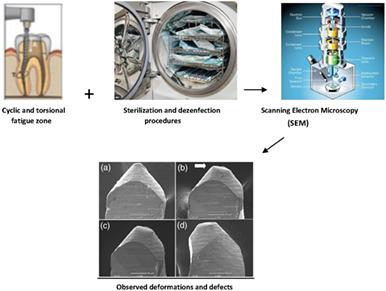当前位置:
X-MOL 学术
›
Microsc. Res. Tech.
›
论文详情
Our official English website, www.x-mol.net, welcomes your
feedback! (Note: you will need to create a separate account there.)
Scanning electron microscopy analysis of conventional and controlled-memory nickel titanium files before and after multi-uses in root canals
Microscopy Research and Technique ( IF 2.0 ) Pub Date : 2021-01-11 , DOI: 10.1002/jemt.23691 Safa Armagan 1 , Faruk Haznedaroglu 1
Microscopy Research and Technique ( IF 2.0 ) Pub Date : 2021-01-11 , DOI: 10.1002/jemt.23691 Safa Armagan 1 , Faruk Haznedaroglu 1
Affiliation

|
The current study aimed to examine changes in the physical properties of conventional and CM nickel–titanium instruments after repeated clinical use, disinfection-sterilization processes, using scanning electron microscopy (SEM). Sixty extracted mandibular molar mesial roots were used in this ex vivo study. The 60 teeth underwent final apical shaping (#25/.06) by the Revo-S SU (Revo-S Group: #25/.06; Micromega; n = 10) and Hyflex CM (Hyflex CM group: #25/.06; Coltene–Whaledent; n = 10) groups. One instrument of each group was used to shape six different teeth (Revo-S SU in 3 MB and 3 ML canals, and Hyflex CM in 3 MB and 3 ML canals), sequentially. The physical changes evident on the surfaces of the files after sequential use and sterilization processes were analyzed by SEM after the first, third, and sixth use. The first SEM examination was performed immediately after removal from the packages. Following first SEM examination, the files were sterilized before the first use as would be customary in practice. Qualitative evaluations were made by two evaluators, according to the following criteria: tip deformation, cutting edge deformation, debris, and microfracture. Revo-S showed a significant difference in cutting edge deformation, tip deformation, and microcrack formation, as compared to Hyflex CM. There was no significant difference between the groups in debris with the increasing number of uses. In this study, Hyflex CM (CM nickel–titanium) files showed better performance in terms of deformation and microcrack formation as the number of uses increased than did Revo-S (conventional nickel–titanium) files.
中文翻译:

根管多次使用前后常规和可控记忆镍钛锉的扫描电镜分析
目前的研究旨在使用扫描电子显微镜 (SEM) 检查常规和 CM 镍钛器械在重复临床使用和消毒灭菌过程后物理特性的变化。在这项离体研究中使用了 60 个提取的下颌磨牙近中根。这 60 颗牙齿通过 Revo-S SU(Revo-S 组:#25/.06;Micromega;n = 10)和 Hyflex CM(Hyflex CM 组:#25/ )进行了最终根尖整形(#25/.06)。 06; Coltene-Whaledent; n = 10) 组。每组的一种器械用于依次塑造六颗不同的牙齿(3 MB 和 3 ML 根管中的 Revo-S SU,以及 3 MB 和 3 ML 根管中的 Hyflex CM)。在第一次、第三次和第六次使用后,通过扫描电镜分析连续使用和灭菌过程后文件表面的明显物理变化。从包装中取出后立即进行第一次 SEM 检查。在第一次扫描电镜检查之后,文件在第一次使用之前按照惯例进行了消毒。由两名评价者根据以下标准进行定性评价:尖端变形、切削刃变形、碎屑和微裂纹。与 Hyflex CM 相比,Revo-S 在切削刃变形、尖端变形和微裂纹形成方面表现出显着差异。随着使用次数的增加,碎片组之间没有显着差异。在这项研究中,随着使用次数的增加,Hyflex CM(CM 镍钛)锉在变形和微裂纹形成方面表现出比 Revo-S(传统镍钛)锉更好的性能。
更新日期:2021-01-11
中文翻译:

根管多次使用前后常规和可控记忆镍钛锉的扫描电镜分析
目前的研究旨在使用扫描电子显微镜 (SEM) 检查常规和 CM 镍钛器械在重复临床使用和消毒灭菌过程后物理特性的变化。在这项离体研究中使用了 60 个提取的下颌磨牙近中根。这 60 颗牙齿通过 Revo-S SU(Revo-S 组:#25/.06;Micromega;n = 10)和 Hyflex CM(Hyflex CM 组:#25/ )进行了最终根尖整形(#25/.06)。 06; Coltene-Whaledent; n = 10) 组。每组的一种器械用于依次塑造六颗不同的牙齿(3 MB 和 3 ML 根管中的 Revo-S SU,以及 3 MB 和 3 ML 根管中的 Hyflex CM)。在第一次、第三次和第六次使用后,通过扫描电镜分析连续使用和灭菌过程后文件表面的明显物理变化。从包装中取出后立即进行第一次 SEM 检查。在第一次扫描电镜检查之后,文件在第一次使用之前按照惯例进行了消毒。由两名评价者根据以下标准进行定性评价:尖端变形、切削刃变形、碎屑和微裂纹。与 Hyflex CM 相比,Revo-S 在切削刃变形、尖端变形和微裂纹形成方面表现出显着差异。随着使用次数的增加,碎片组之间没有显着差异。在这项研究中,随着使用次数的增加,Hyflex CM(CM 镍钛)锉在变形和微裂纹形成方面表现出比 Revo-S(传统镍钛)锉更好的性能。











































 京公网安备 11010802027423号
京公网安备 11010802027423号